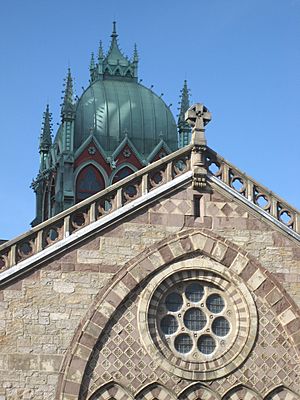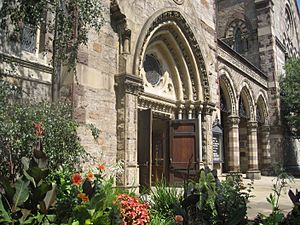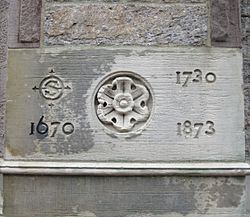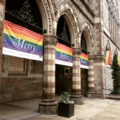Old South Church facts for kids
|
Old South Church in Boston
|
|
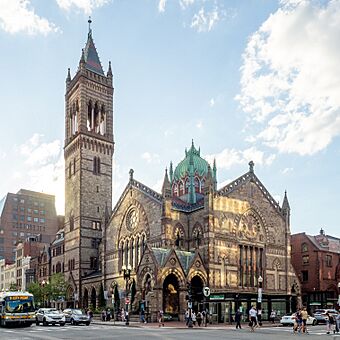 |
|
| Location | 645 Boylston St, Boston, Massachusetts, U.S. |
|---|---|
| Built | 1873 |
| Architect | Charles Amos Cummings and Willard T. Sears |
| Architectural style | Gothic Revival |
| NRHP reference No. | 70000690 |
Quick facts for kids Significant dates |
|
| Added to NRHP | December 30, 1970 |
| Designated NHL | December 30, 1970 |
Old South Church is a very old and important church in Boston, Massachusetts. It's also known as New Old South Church or Third Church. This church community started way back in 1669.
The building you see today at 645 Boylston Street was finished in 1873. It was designed in a style called Gothic Revival, which means it looks like old European churches and castles. The architects were Charles Amos Cummings and Willard T. Sears. Later, between 1935 and 1937, other architects named Allen & Collens made it even bigger. The church is located on Copley Square in an area of Boston called Back Bay, which was built on land that used to be water. Because of its beautiful design, Old South Church was named a National Historic Landmark in 1970. It's one of the oldest church groups in the United States.
Contents
History of Old South Church
How the Church Started
Old South Church began in 1669. It was formed by a group of Congregationalists who wanted to create a new church separate from Boston's First Church. They called themselves the Third Church because there were already two other Congregational churches in the city.
At first, the church members met in a building called the Cedar Meeting House, starting in 1670. Later, in 1729, they moved to the Old South Meeting House on Washington and Milk Streets.
Famous People and Events
Many important people were part of the Old South Church community. Some of them include John Alden, Samuel Adams, William Dawes, Benjamin Franklin, Samuel Sewall, and Phillis Wheatley.
In 1773, a very famous event happened at the Old South Meeting House. Samuel Adams gave the signal from there that started the Boston Tea Party. This was a key moment leading up to the American Revolution.
Changes and Growth
In the early 1800s, many churches in Boston changed their beliefs. But Old South Church stuck to its original teachings. In 1816, it teamed up with Park Street Church to create the City Mission Society. This group worked to help poor people in Boston.
During the American Civil War, Old South Church became a place where people could sign up to join the Union Army. Even though not everyone in the church was against slavery, they strongly supported the Union side. After the war, the church became more welcoming to different kinds of people. In 1875, the church moved to its current location in the Back Bay and into the new building you see today.
Into the 20th century, Old South Church continued its work to help the city. It has welcomed people from many different backgrounds, including various races, social classes, and sexual orientations. The church has officially stated its belief in equality, social justice, and peace for everyone.
Church Building Design
The Old South Church building was designed between 1870 and 1872 by the Boston architects Cummings and Sears. They used a style called Venetian Gothic, which was inspired by buildings in Venice, Italy. This style followed the ideas of a British writer named John Ruskin. Old South Church is one of the best examples in America of how Ruskin's ideas influenced architecture.
The outside of the church is mostly made of a stone called Roxbury Conglomerate, which looks like puddingstone. Many parts of the church have stripes of yellow-beige and deep red sandstone. The big arches and towers are decorated with fancy ironwork. The roof has stripes of red and dark gray tiles and decorative iron along the edges.
The Tall Tower (Campanile)
A very tall tower, called a campanile, is a special part of Old South Church. You can see it from many parts of Boston. The tower is on the west side of the church and is 246 feet tall. It holds the church's 2,020-pound bell.
This is actually the second tower built on this spot. The first one, finished in 1875, started to lean in the late 1920s because the ground underneath was too soft. So, the church hired architects Allen & Collens to design a new, stronger tower. The old tower was taken down, and a new one was built using strong steel supports. Today, the tower is checked every year and is very stable. The bell can now swing fully again, thanks to a new bell wheel installed in 2006.
The Lantern
Above the main part of the church, on the east side, there's a copper-covered dome called a lantern. It has twelve fancy Gothic windows. This part looks a lot like the domes on the Basilica of St. Mark in Venice. The lantern isn't just for looks; it also helps cool the church inside. Before air conditioning, its windows could be opened to let air flow through.
Inside the Church: Decorative Arts
The inside of Old South Church is very rich and detailed, but also calm. It uses many beautiful materials like carved Italian cherry wood, limestone, painted plaster, and stained glass.
When you enter the main worship area, called the sanctuary, you pass through a screen made of French Caen limestone. This screen is carved in the Venetian Gothic style. If you look closely, you can find hidden animals like a squirrel, lizard, owl, and snail carved into the leaves. You can also find similar animal carvings on the outside of the building.
Behind the choir, at the east end of the church, there's a wooden screen with arches and clover-like shapes. These designs are inspired by the Doge's Palace, Venice in Venice. The beautiful stained glass windows were made by an English company called Clayton and Bell. They look like glass from the 15th century.
The 1875 Look
When Old South Church opened in 1875, it looked very much like it does today. The walls were painted with colorful patterns in shades of red, yellow, green, and gray, with touches of gold. The ceiling of the lantern, high above, was painted a deep blue with gold stars, like the night sky. The carvings of leaves and animals, along with the starry ceiling, were meant to remind people of God's creation. Above the doors on the east walls, there are glass mosaics of the tree of life by Antonio Salviati. All these details made the inside of the church feel very special and spiritual.
The 1905 Tiffany Style
In 1905, the church hired Louis Comfort Tiffany to redecorate the sanctuary. Tiffany was a famous American artist known for his unique designs. He believed in the importance of handmade art. Tiffany had decorated many famous places, including parts of the White House.
For Old South Church, Tiffany covered the stained glass windows with purple-tinted glass. The original painted walls were changed to purple and then decorated with silver patterns that looked like mother-of-pearl. This created a very rich and detailed look, all using a limited color palette.
The 1950s Simpler Look
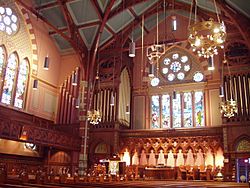
In the early 1950s, the church was renovated again, this time with a much simpler style. Louis Comfort Tiffany's colorful paint and patterns were covered with light gray paint. The purple glass over the stained glass was removed, and the opening in the cupola was closed. This simpler look was a big change from the earlier, more decorated styles.
Bringing Back the Original Look
In 1984, a project began to restore the church's interior to how it looked in 1875. Researchers used old photos and studied the original paint colors. The walls were repainted in the original rose red color, and the detailed patterns from Cummings and Sears were recreated. The cupola was reopened, letting light into the sanctuary again. This restoration brought back the beautiful, colorful look of the church's early days.
The Church Organ
Old South Church has a huge organ called Opus 308. It was built in 1921 by E. M. Skinner & Company. This organ was originally in a theater in St. Paul, Minnesota, and was moved to the church in 1985 when that building was torn down.
The organ started with 82 sets of pipes and 5,728 pipes in total. Now, it has 115 sets of pipes and 7,625 pipes! These pipes range in size from tiny (0.25 inches) to very long (32 feet).
The organ's keyboard and controls are behind the pulpit. They can be raised up for concerts or lowered for regular church services. The pipes are hidden behind and to the sides of the main worship area, and also at the back of the balcony.
In December 2008, construction at the nearby MBTA Copley station caused a crack in the church's outside wall and some damage inside. Because of this, the organ couldn't be used for a few months to prevent more damage. It was fixed and used again just before Easter in 2009.
The Bay Psalm Book
Old South Church owns one of the very first books ever printed in what became the United States. It's called the Bay Psalm Book, and it was printed in 1640. Only eleven copies of this first edition still exist today.
Until 2013, Old South Church actually owned two of these rare books! One was sold at an auction. The church's remaining copy of the Bay Psalm Book is kept safely in the Rare Books Department of the Boston Public Library.
Senior Ministers
Many leaders, called Senior Ministers, have served the Old South Church community over the years. Here are some of them:
- At Cedar Meeting House
- Thomas Thacher (1670-1678)
- Samuel Willard (1678-1707)
- Ebenezer Pemberton (1700-1717)
- Joseph Sewall (1713-1769)
- Thomas Prince (1718-1730)
- At Old South Meeting House
- Thomas Prince (1730-1758)
- Alexander Cumming (1761-1763)
- Samuel Blair (1766-1769)
- John Hunt/John Bacon (1771-1775)
- Joseph Eckley (1779-1811)
- Joshua Huntington (1808-1819)
- Benjamin B. Wisner (1821-1832)
- Samuel H. Stearns (1834-1836)
- George W. Blagden (1836-1872)
- Jacob M. Manning (1857-1882)
- At Old South Church (current building)
- George Angier Gordon (1884-1927)
- Russell Henry Stafford (1927-1945)
- Frederick M. Meek (1946-1973)
- James W. Crawford (1974-2002)
- Carl F. Schultz Jr. (2002-2005) (Interim)
- Nancy S. Taylor (2005-2022)
- Rich Spalding (2022-2023) (Interim)
- John M Edgerton (2023 - present)
Images for kids
See also


